CLEO:2011 Postdeadline Papers
PDPB5 20:40
Pump-Probe Melanoma Imaging: Applications to High-Resolution and In-Vivo Microscopy,
Jesse W. Wilson1,
Thomas E. Matthews1, Simone Degan1, Jennifer Y. Zhang2,
Mary Jane Simpson1, Warren S. Warren1,3;
1Chemistry, Duke
Univ., USA;
2Dermatology, Duke Univ., USA;
3Biomedical
Engineering, Duke Univ., USA.
Pump-probe imaging of
melanin with near-infrared pulses has been extended to
two new domains: high-resolution imaging of the
melanin content of melanosomes in an individual
melanocyte and epi-detected in vivo microscopy of a
developing melanoma.
more
Product news and updates - Training Workshops
- Featured Customer - Other News
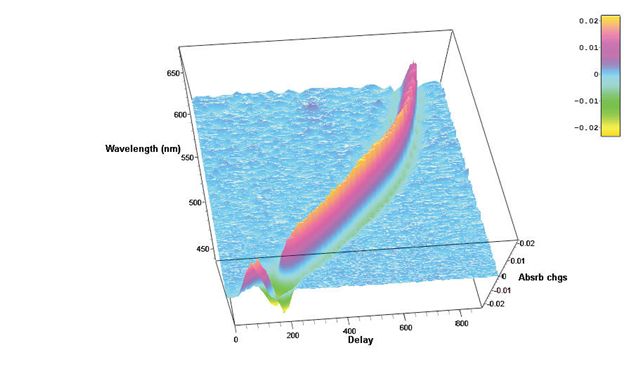 |
Hatteras-D
femtosecond transient absorption data acquisition system
Future nanostructures and biological nanosystems will take
advantage not only of the small dimensions of the objects but of the
specific way of interaction between nano-objects. The interactions
of building blocks within these nanosystems will be studied and optimized on
the
femtosecond time scale - says Sergey Egorov, President and CEO of Del Mar
Photonics, Inc. Thus we put a lot of our efforts and resources into the
development of new Ultrafast
Dynamics Tools such as our Femtosecond Transient Absorption Measurements
system Hatteras. Whether you want to
create a new photovoltaic system that will efficiently convert photon energy
in charge separation, or build a molecular complex that will dump photon energy
into local heat to kill cancer cells, or create a new fluorescent probe for
FRET microscopy, understanding of internal dynamics on femtosecond time scale
is utterly important and requires advanced measurement techniques.Reserve a
spot in our Ultrafast Dynamics Tools
training workshop in San Diego, California.
|
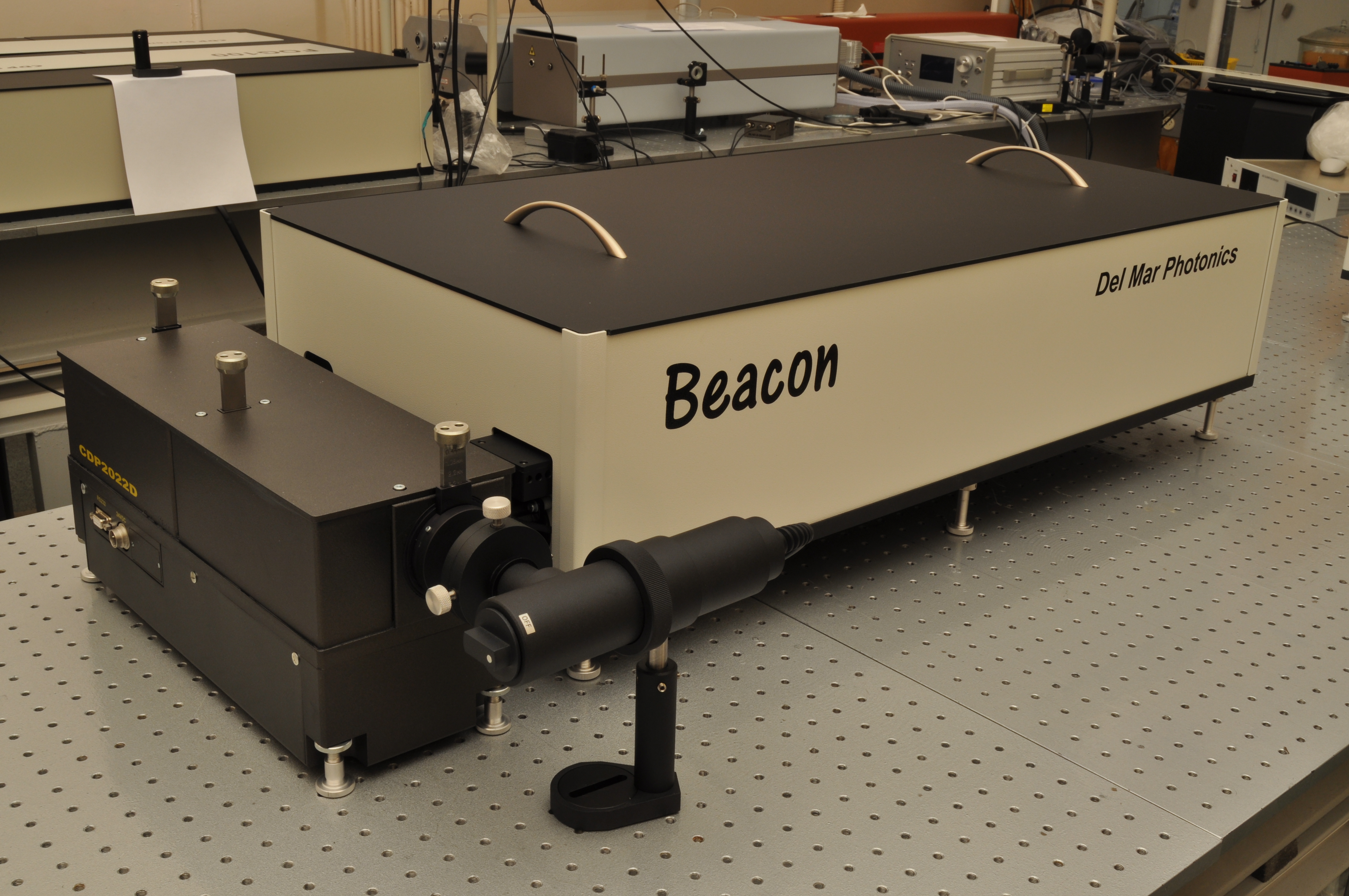 |
Beacon Femtosecond Optically Gated Fluorescence Kinetic Measurement System
-
request a quote -
pdf
Beacon together with Trestles Ti:sapphire oscillator, second and third harmonic
generators. Femtosecond optical gating (FOG) method gives best temporal
resolution in light-induced fluorescence lifetime measurements. The resolution
is determined by a temporal width of femtosecond optical gate pulse and doesn't
depend on the detector response function. Sum frequency generation (also called
upconversion) in nonlinear optical crystal is used as a gating method in the
Beacon femtosecond fluorescence kinetic measurement system. We offer
Beacon-DX for operation together with Ti: sapphire femtosecond oscillators
and Beacon-DA for operation together with femtosecond amplified pulses.
Reserve a
spot in our Ultrafast Dynamics Tools
training workshop in San Diego, California.
|
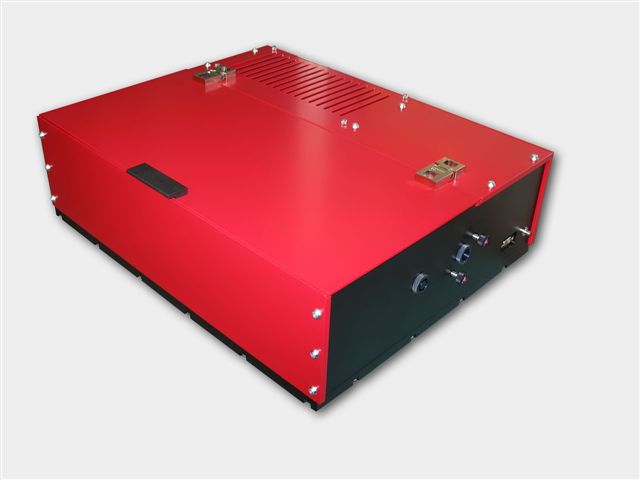 |
Trestles LH Ti:Sapphire
laser
Trestles LH is a new series of high quality femtosecond Ti:Sapphire
lasers for applications in scientific research, biological imaging, life
sciences and precision material processing. Trestles LH includes integrated
sealed, turn-key, cost-effective, diode-pumped
solid-state (DPSS). Trestles LH lasers offer the most attractive pricing
on the market combined with excellent performance and reliability. DPSS LH
is a state-of-the-art laser designed for todays applications. It combines
superb performance and tremendous value for todays market and has
numerous advantages over all other DPSS lasers suitable for Ti:Sapphire
pumping. Trestles LH can be customized to fit customer requirements and
budget. Reserve a
spot in our Femtosecond lasers training
workshop in San Diego, California. Come to learn how to build a
femtosecond laser from a kit
|
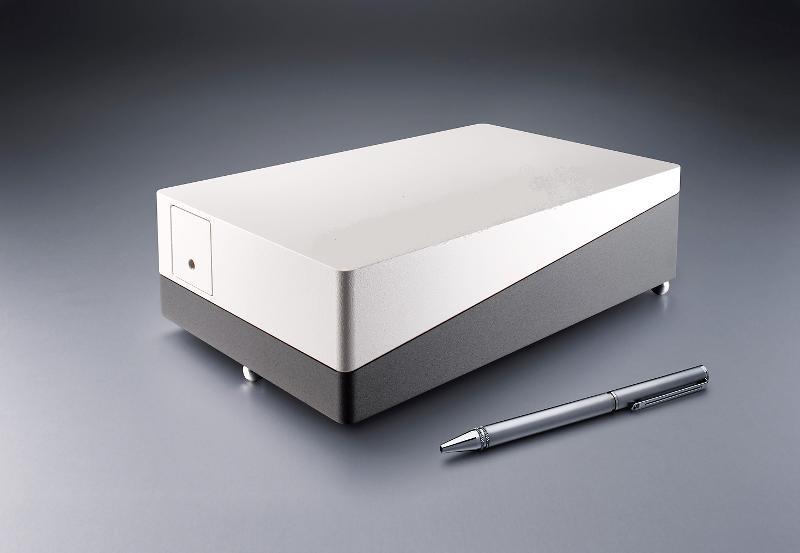 |
DPSS DMPLH lasers
DPSS DMP LH series lasers will pump your Ti:Sapphire laser.
There are LH series lasers installed all over the world pumping all makes & models
of oscillator. Anywhere from CEP-stabilized femtosecond Ti:Sapphire oscillators
to ultra-narrow-linewidth CW Ti:Sapphire oscillators. With up to 10 Watts CW
average power at 532nm in a TEMoo spatial mode, LH series
lasers has quickly proven itself
as the perfect DPSS pump laser for all types of Ti:Sapphire or dye laser.
Ideal for pumping of:
Trestles LH
Ti:Sapphire laser
T&D-scan laser
spectrometer based on narrow line CW Ti:Sapphire laser
|
 |
New laser spectrometer
T&D-scan for research that
demands high resolution and high spectral
density in UV-VIS-NIR spectral domains - now available with
new pump option!
The
T&D-scan
includes
a CW ultra-wide-tunable narrow-line laser, high-precision wavelength meter,
an electronic control unit driven through USB interface as well as a
software package. Novel advanced design of the fundamental laser component
implements efficient intra-cavity frequency doubling as well as provides a
state-of-the-art combined ultra-wide-tunable Ti:Sapphire & Dye laser
capable of covering together a
super-broad spectral range between 275 and 1100 nm. Wavelength
selection components as well as the position of the non-linear crystal are
precisely tuned by a closed-loop control
system, which incorporates highly accurate wavelength meter.Reserve a
spot in our CW lasers training
workshop in San Diego, California. Come to
learn how to build a
CW
Ti:Sapphire laser from a kit
|
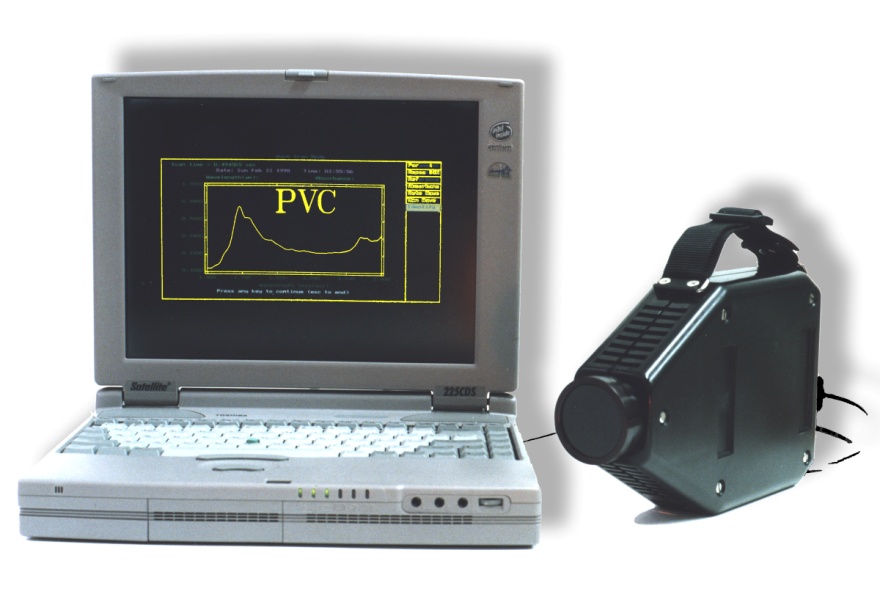 |
AOTF Infrared Spectrometer
Del Mar Photonics offer a handheld
infrared spectrometer based on the
acousto-optic tunable filter (AOTF). This instrument is about the size and
weight of a video camera, and can be battery operated. This unique, patented
device is all solid-state with no moving parts. It has been sold for a wide
variety of applications such as liquid fuel analysis, pharmaceutical analysis,
gas monitoring and
plastic analysis.
Miniature AOTF infrared spectrometer uses
a crystal of tellurium dioxide to scan the wavelength. Light from a light source enters
the crystal, and is diffracted into specific wavelengths. These wavelengths are
determined by the frequency of the electrical input to the crystal. Since there
are no moving parts, the wavelength scanning can be extremely fast. In addition,
specific wavelengths can be chosen by software according to the required algorithm, and therefore can be modified without changing the
hardware. After the infrared radiation reflects off of the sample, it is
converted into an electrical signal by the detector and analyzed by the
computer. Del Mar Photonics is looking for international distributors for
RAVEN - AOTF IR spectrometer for plastic identification and for variety of
scientific and industrial collaborations to explore futher commercial potential
of AOTF technology.
|
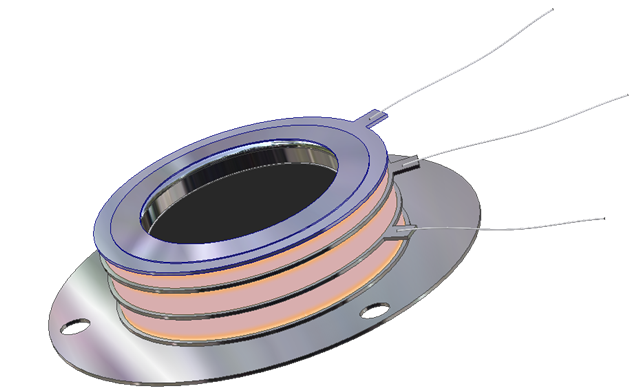 |
Open Microchannel Plate Detector
MCP-MA25/2 -
now in stock!
Microchannel Plate Detectors MCP-MA series are an open MCP detectors
with one or more microchannel plates and a single metal anode. They are intended
for time-resolved detection and make use of high-speed response properties of
the MCPs. MCP-MA detectors are designed for photons and particles detection in
vacuum chambers or in the space.
MCP-MA detectors are used in a variety of applications including UV, VUV and EUV
spectroscopy, atomic and molecular physics, TOF massspectrometry of clusters
and biomolecules, surface studies and space research.
MCP-MA detectors supplied as a totally assembled unit that can be easily mounted
on any support substrate or directly on a vacuum flange. They also can be
supplied premounted on a standard ConFlat flanges.
buy online -
ask for research discount!
|
 |
Hummingbird EMCCD camera
The digital Hummingbird
EMCCD camera combines high sensitivity, speed and high resolution.
It uses Texas Instruments' 1MegaPixel Frame Transfer Impactron device which
provides QE up to 65%.
Hummingbird comes with a standard CameraLink output.
It is the smallest and most rugged 1MP EMCCD camera in the world.
It is ideally suited for any low imaging application such as hyperspectral
imaging, X-ray imaging, Astronomy and low light surveillance.
It is small, lightweight, low power and is therefore the ideal camera for
OEM and integrators.
buy online |
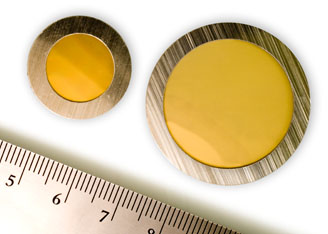 |
Terahertz systems, set ups and components
New band pass and long pass THz optical filters based on porous silicon and metal mesh technologies.
Band pass filters with center wavelengths from 30 THz into GHz range and transmissions up to 80% or better. Standard designs
with clear aperture diameters from 12.5 to 37.5 mm.
Long pass filters with standard rejection edge wavelengths from 60 THz into GHz range. Maximum transmission up to 80% or
better, standard designs at 19.0 and 25.4 mm diameters.
Excellent thermal (from cryogenic to 600 K) and mechanical properties
Need complet THz set up? Check different options available from Del Mar Photonics or e-mail us for custom set up!
Ready to buy complet THz Spectrometer? Trestles Pacifica THz Time Domain Spectrometer is a modular tabletop
system for scientific and industrial applications of pulsed THz radiation.
|
 |
iPCA - interdigital Photoconductive Antenna for terahertz waves
Large area broadband antenna with lens array and high emitter conversion
efficiency
iPCA with LT-GaAs absorber, microlens array for laser excitation wavelengths
l £ 850
nm, adjusted hyperhemispherical silicon lens with a high power conversion
efficiency of 0.2 mW THz power / W optical power. The iPCA can be used also
as large area THz detector. The two types iPCAp and iPCAs have the same
active interdigital antenna area but different contact pad directions with
respect to the electrical THz field.
Interdigital Photoconductive Antenna for terahertz waves generation using
femtosecond Ti:Sapphire laser
THz books |
 |
IntraStage lowers the cost
of test data management!
Struggling with gigabytes or terabytes of test data?
IntraStage easily transforms test
data from disparate sources into web-based quality metrics and engineering
intelligence you can use.
Contact
us today to discuss your test management requirements and specifications of your
application.
|
Training Workshops
Featured Customer
 |
Trestles LH10-fs/CW laser system at UC Santa Cruz Center of
Nanoscale Optofluidics
Del
Mar Photonics offers new
Trestles fs/CW laser system which can be easily
switched from femtosecond mode to CW and back. Having both modes of operation in one system dramatically increase a
number of applications that the laser can be used for, and makes it an ideal
tool for scientific lab involved in multiple research projects.
Kaelyn Leake is a PhD student in Electrical Engineering. She graduated from
Sweet Briar College with a B.S. in Engineering Sciences and Physics. Her
research interests include development of nanoscale optofluidic devices and
their applications. Kaelyn is the recipient of a first-year QB3 Fellowship.
In this video Kaelyn talks about her experimental research in nanoscale
optofluidics to be done with Trestles LH laser.
Reserve a spot in our
femtosecond Ti:Sapphire training workshop in San
Diego, California during summer 2011 |
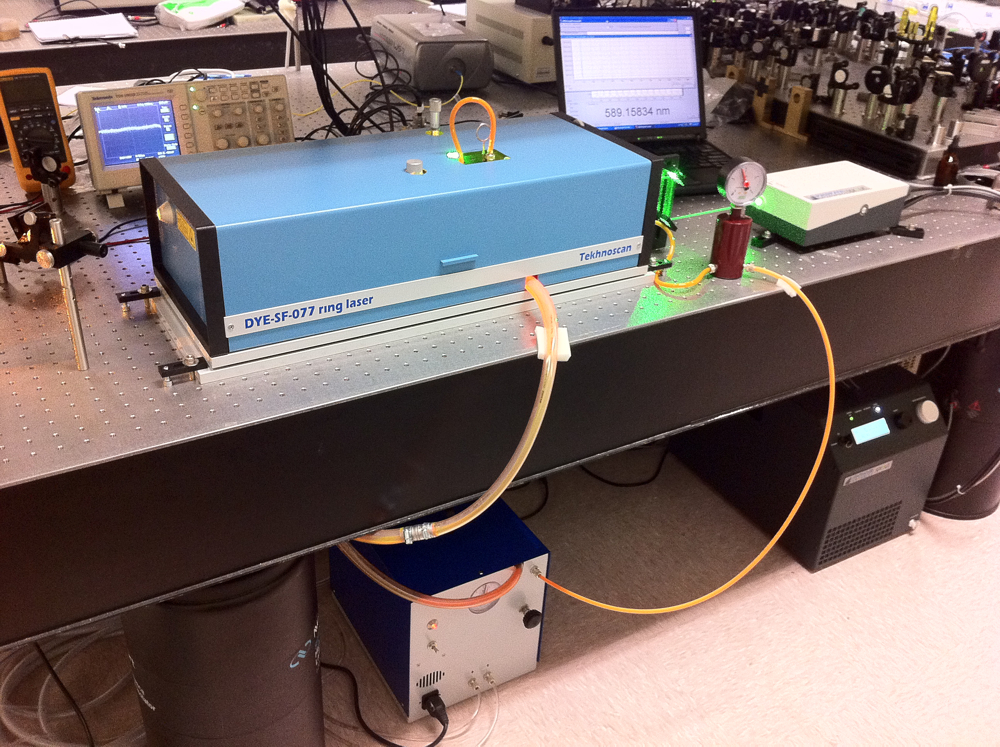 |
Frequency-stabilized CW
single-frequency ring Dye laser DYE-SF-007 pumped by DPSS DMPLH laser installed
in the brand new group of Dr. Dajun Wang at the The Chinese University of Hong
Kong.
DYE-SF-077 features exceptionally narrow generation line width, which
amounts to less than 100 kHz. DYE-SF-077 sets new standard for generation
line width of commercial lasers. Prior to this model, the narrowest line-width
of commercial dye lasers was as broad as 500 kHz - 1 MHz. It is necessary to
note that the 100-kHz line-width is achieved in DYE-SF-077 without the use of an
acousto-optical modulator, which, as a rule, complicates the design and
introduces additional losses. A specially designed ultra-fast PZT is used for
efficient suppression of radiation frequency fluctuations in a broad frequency
range. DYE-SF-077 will be used in resaerch of Ultracold polar molecules,
Bose-Einstein condensate and quantum degenerate Fermi gas and High resolution
spectroscopy |
Other News
Nd:YAG laser ordered by the University of Leon, UANL, Mexico
Wedge 50 Multipass Amplifier pumped with a Darwin-527-30-M DPSS Laser
ordered by Hong Kong customer
New
Trestles LH10-fs/CW femtosecond+CW laser ready for delivery to the
University of California Santa Cruz
Trestles femtosecond
Ti:Sapphire laser delivered to North Carolina State
University
Del Mar Photonics sponsor IONS (International OSA Network of Students)
conference IONS-NA-2 in Tucson, Arizona
IONS-NA-2
website
Best talk and best
poster awards at IONS-Moscow 2010 conference sponsored by Del Mar Photonics
Watch Del Mar Photonics
videos!
Del Mar Photonics is now on Twitter!
Del Mar Photonics featured components
Del Mar Photonics continuously expands its components
portfolio.
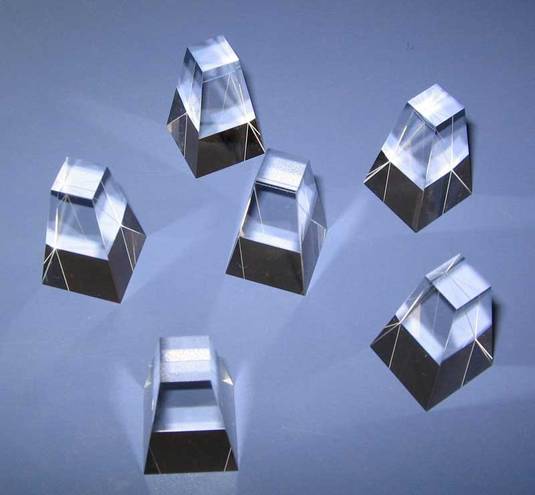
|
Solar
Prisms for Concentrating Photovoltaic Systems (CPV)
Solar cells made of compound semiconductors such
as gallium arsenide are very expensive. Usually very small cells are
installed and various means such as mirrors, lenses, prisms, etc..are used
to concentrate sunlight on the cells. Concentration photovoltaic technology
(CPV) uses the solar radiation with an efficiency of 40%, double that of
conventional solar cells
Del Mar Photonics design custom Concentrating Photovoltaic Systems (CPV) and
supply variety of the optical components for CPV such as
solar prisms shown in the picture.
hexagonal light pipes,
optical rods |
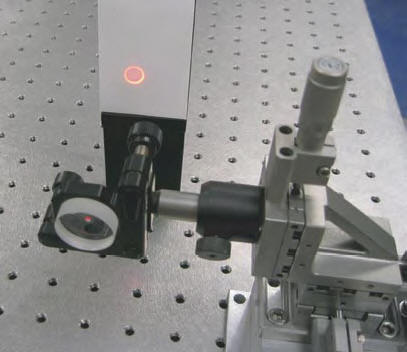
|
Axicon Lens
Axicon lens also known as conical lens or rotationally symmetric prism is
widely used in different scientific research and application. Axicon can be
used to convert a parallel laser beam into a ring, to create a non
diffractive Bessel beam or to focus a parallel beam into long focus depth.
Del Mar Photonics supplies axicons with cone angles range from 130° to
179.5° for use with virtually any laser radiation. We manufacture and supply
axicons made from BK7 glass, fused silica and other materials.
download brochure -
request a quote |
 |
Rutile (TiO2) coupling
prisms
Del Mar Photonics offers optical elements made of high quality synthetically
grown Rutile Titanium Dioxide crystals. Rutiles strong birefringency, wide
transmission range and good mechanical properties make it suitable for
fabrication of polarizing cubes, prisms and optical isolators. Boules having
high optical transmission and homogeneity are grown by proprietary method.
Typical boules have 10 - 15 mm in dia. and up to 25 mm length. Optical
elements sizes - from 2 x 2 x 1 mm to 12.7 x 12.7 x 12.7 mm. Laser grade
polish quality is available for finished elements. So far we the largest
elements that we manufactured are 12 x15 x 5 mm, in which optical axis is
parallel to 15 mm edge, 5 mm is along beam path, 12 x 15 mm faces polished
20/10 S/D, one wave flatness, parallelism < 3 arc.min. (better specs.
available on request).
more details -
download brochure -
request a quote |
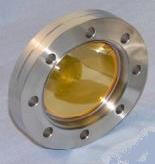 |
Vacuum viewport
Del Mar Photonics offer a range of competitively priced UHV viewports ,
Conflat, ISO or KF including a variety of coatings to enhance performance.
Del Mar Photonics viewports are manufactured using advanced techniques for
control of special and critical processes, including 100 percent helium leak
testing and x-ray measurements for metallization control. Windows Materials
include: Fused silica, Quartz , Sapphire , MgF2, BaF2, CaF2, ZnSe, ZnS, Ge,
Si, Pyrex. Standard Viewing diameters from .55" to 1.94 ".
Coating - a range of custom coatings can applied - which include
- Single QWOT
- Broad Band AR
- V coatings
- ITO
- DLC (Diamond like coating)
more
details -
request a
quote
|
 |
Hydrogen
Thyratrons are used in
such devices as radars with different power levels, high-power pulsed
technical, electrophysical, medical devices and lasers. Sophisticated
design and high quality ceramic-metal envelope determines long lifetime
and very accurate and reliable operation of hydrogen thyratrons under wide range of environmental
conditions.
Applications:
- radars
- pulsed lasers power supplies
- medical apparatus
- electrophysical instrumentation
Triggered Three-Electrode Spark Gap Switches are ceramic-metal sealed off gas
discharge trigatron-type devices with a co-axial trigger electrode. These Gas
Discharge Tubes contain no mercury and, due to an advanced design, feature high
reliability and a long lifetime being operating under wide range of
environmental conditions.
Applications:
- pulsed installation for processing materials
- installations with plasma focus
- pulse power supplies for lasers and other pulse equipment
- medical apparatus such as lithotriptors and defibrillators
- processing systems for petroleum wells |
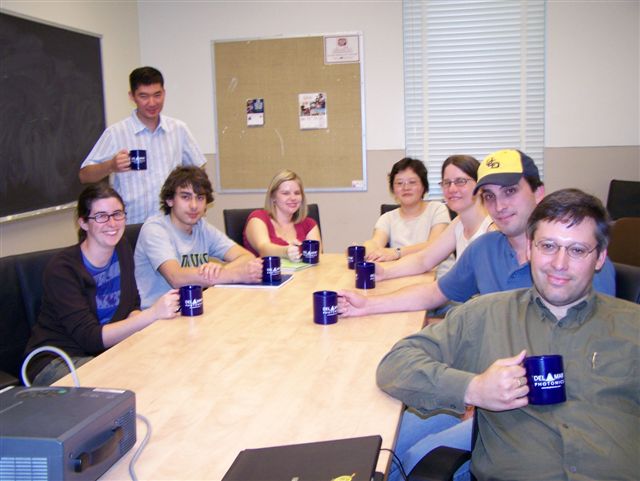 |
We are looking forward to hear from you and help you with
your optical and crystal components requirements. Need time to think about
it?
Drop us a line and we'll send you beautiful Del Mar Photonics mug (or
two) so you can have a tea party with your colleagues and discuss your
potential needs. |

Del Mar Photonics, Inc.
4119 Twilight Ridge
San Diego, CA 92130
tel: (858) 876-3133
fax: (858) 630-2376
Skype: delmarphotonics
sales@dmphotonics.com
CLEO: Science & Innovations 6: Optical Materials,
Fabrication and Characterization
PDPA2 20:10
Direct‐Bandgap Germanium Active Layers Pumped
Above Transparency Based on Tensilely Strained
Nanomembranes, Cicek Boztug1, Feng Chen2, Jose Sanchez‐
Perez2, Faisal Sudradjat1, Deborah Paskiewicz2, R. B.
Jacobson2, Max Lagally2, Roberto Paiella1; 1Boston Univ.,
USA; 2Univ. of Wisconsin ‐ Madison, USA. We show that
mechanically stressed nanomembranes can be used to
introduce sufficient tensile strain in Ge to transform it
into a direct‐bandgap, efficient light‐emitting material
that can support population inversion and thus provide
optical gain.
CLEO: Science & Innovations 4: Applications of
Nonlinear Optics
PDPA3 20:20
Intracavity Parametric Fluorescence in Diode Lasers,
Bhavin J. Bijlani1, Payam Abolghasem1, Amr S. Helmy1; 1ECE,
Univ. of Toronto, Canada. Self‐pumped parametric
fluorescence was observed in GaAs/AlGaAs Bragg
reflection lasers with Chi(2) phase‐matched. With a 967
nm pump, signal and idler around 2300 nm and 1700 nm
were measured, with record conversion efficiency of 4176
%W‐1cm‐2.
CLEO: Science & Innovations 14: Optical Metrology
PDPA4 20:30
Mid‐Infrared Frequency Combs Based on
Microresonators, Christine Wang1,3, Tobias Herr2, Pascal
DelʹHaye1,3, Albert Schliesser1,2, Ronald Holzwarth1,3, Theodor
W. Haensch1,4, Nathalie Picqué1,5, Tobias Kippenberg1,2; 1Max‐
Planck Inst. for Quantum Optics, Germany; 2École
Polytechnique Fédérale de Lausanne, Switzerland; 3Menlo
Systems GmbH, Germany; 4Physics, Ludwig‐Maximilians‐
Univ. München, Germany; 5Inst. des Sciences Moléculaires
dOrsay, CNRS, France. We demonstrate mid‐infrared
frequency comb generation from microresonators. Combs
spanning over more than 10 THz around the 2.5 μmwavelength
cw‐pump are generated in crystalline MgF2
whispering‐gallery mode resonators via four‐wavemixing.
PDPA5 20:40
Self‐Referenced Frequency Comb From a Tm‐fiber
Amplifier via PPLN Waveguide Supercontinuum
Generation, Christopher Phillips2, Jie Jiang1, Carsten
Langrock2, Martin M. Fejer2, Martin E. Fermann1; 1IMRA
America, USA; 2Stanford Univ., USA. We demonstrate a
coherent 2‐μm Tm fiber laser frequency comb with a selfreferenced
carrier envelope offset frequency by
performing octave‐spanning supercontinuum generation
in a periodically poled LiNbO3 waveguide.
CLEO: QELS Fundamental Science 5: Nonlinear Optics
and Novel Phenomena
PDPA6 20:50
Octave‐Spanning Supercontinuum Generation in
CMOS‐Compatible Silicon Nitride Waveguides, Robert
Halir1,2, Yoshitomo Okawachi3, Jacob S. Levy4, Mark A.
Foster5, Michal Lipson2,4, Alexander L. Gaeta3; 1Departamento
Ingeniería de Comunicaciones, ETSI Telecomunicación,
Universidad de Málaga, Spain; 2Kavli Inst. at Cornell for
Nanoscale Science, Cornell Univ., USA; 3Applied and
Engineering Physics, Cornell Univ., USA; 4School of Electrical
and Computer Engineering, Cornell Univ., USA; 5Dept. of
Electrical and Computer Engineering, Johns Hopkins Univ.,
USA. We demonstrate ultrabroadband supercontinuum
generation in CMOS‐compatible dispersion engineered
silicon‐nitride waveguides. Our process produces a
supercontinuum spectrum extending over 1.6 octaves
from 665 nm to 2025 nm using 160 pJ pulses.
CLEO: Science & Innovations 8: Ultrafast Optics,
Optoelectronics and Applications
PDPA7 21:00
Spectral Line‐by‐Line Pulse Shaping of an On‐Chip
Microresonator Frequency Comb, Fahmida Ferdous1,
Houxun Miao2,3, Daniel E. Leaird1, Kartik Srinivasan2, Jian
Wang1,4, Lei Chen2, Leo T. Varghese1,4, Andrew M. Weiner1,4;
1ECE, Purdue Univ., USA; 2Center for Nanoscale Science and
Technology, National Inst. of Standards and Technology, USA;
3Nanocenter, Univ. of Maryland, USA; 4Birck Nanotechnology
Cente, Purdue Univ., USA. We report spectral phase
characterization and optical arbitrary waveform
generation of on‐chip microresonator combs. Random
relative frequency shifts due to uncorrelated variations of
frequency dependent phase are at or below the 100 μHz
level.
CLEO: Science & Innovations 7: Micro‐ and Nano‐
Photonic Devices
PDPA8 21:10
Controlled Coupling in Silicon Microrings for High‐
Speed, High Extinction Ratio, and Low‐Chirp
Modulation, Wesley D. Sacher1, William M. Green2, Solomon
Assefa2, Tymon Barwicz2, Steven M. Shank3, Yurii A. Vlasov2,
Joyce Poon1; 1Electrical and Computer Engineering, Univ. of
Toronto, Canada; 2IBM Thomas J. Watson Res. Ctr., USA;
3IBM Systems &Technology Group, USA. Silicon‐oninsulator
microring modulators with integrated Mach‐
Zehnder interferometer couplers exhibiting drive voltage
swings near 1 V, modulation insertion loss < 1 dB,
extinction ratios as large as 16 dB, and low chirp are
demonstrated.
CLEO: Science & Innovations 2: Solid‐State, Liquid,
Gas, and High‐Intensity Lasers
PDPA9 21:20
1.16 PW sub‐30fs Ti:sapphire laser system by seeding
with optical parametrical amplified femtosecond laser,
Zhiyi Wei1, Zhaohua Wang1, Cheng Liu1, Zhongwei Shen1,
Qing Zhang1; 1Lab of Optical Physics, Inst. of Physics, China.
We generated 32J laser pulse at 27fs from a Ti:sapphire
laser facility based on chirped‐pulse amplification with
optical parametrical amplified femtosecond laser as new
seeding, result in peak power of 1.16 PW with high
contrast.
CLEO: Science & Innovations 8: Ultrafast Optics,
Optoelectronics and Applications
PDPA10 21:30
1‐GW‐Peak‐Power, Cr:ZnSe Laser, Peter Moulton1, Evgeni
Slobodchikov1; 1Q‐Peak Inc., USA. We report the first, to our
knowledge, femtosecond, oscillator, chirped‐pulse,
regenerative‐amplifier system based Cr:ZnSe. To date, we
have generated, at a 1‐kHz rate, 0.3‐mJ, 300‐fs pulses (1
GW peak power) centered at 2475 nm.
CLEO: Science & Innovations 11: Fiber Amplifiers,
Lasers and Devices
PDPA11 21:40
Demonstration of a Raman fiber distributed feedback
laser, Paul S. Westbrook1, Kazi S. Abedin1, Jeffrey W.
Nicholson1, Tristan Kremp1, Jerome Porque1; 1OFS Labs, USA.
We demonstrate a fiber distributed feedback laser
oscillator using Raman gain in a 124mm germanosilicate
fiber grating at 1584nm. We measure a 6MHz signal
linewidth, more than 1000x smaller than previous Raman
fiber laser oscillators.
CLEO: Science & Innovations 6: Optical Materials,
Fabrication and Characterization
PDPA12 21:50
Giant Optical Gain in a Rare‐earth‐ion‐doped
Waveguide, Dimitri Geskus1, Shanmugam Aravazhi1, Sonia
M. Garcia‐Blanco1, Markus Pollnau1; 1MESA+ Inst. for
Nanotechnology, Univ. of Twente, Netherlands. By exploiting
large transition cross‐sections, high dopant concentration,
and strong light confinement, 950 dB/cm gain is
demonstrated in a KGdxLu1‐x(WO4)2:Yb3+ channel
waveguide, representing a hundred‐fold improvement in
rare‐earth‐ion‐doped materials.
PDPB Postdeadline Session II
Room 317
20:0022:00
James Tunnell, Univ. of Texas, USA, Presider
CLEO: Science & Innovations 2: Solid‐State, Liquid,
Gas, and High‐Intensity Lasers
PDPB1 20:00
375 W, 20 kHz, 1.5 ns Nd:YAG Planar Waveguide
MOPA, Gregory Wagner1, Berton Callicoatt1, Glenn Bennett1,
Michael Tartaglia1, Sam Field1, Andrew Malm1, Christopher
Ryan1; 1Lockheed Martin Coherent Technologies, USA. We
present a high‐power, pulsed Nd:YAG MOPA consisting
of a passively Q‐switched oscillator and three planar
waveguide amplifiers. This unique laser produced 375 W
at 20 kHz PRF with 1.6 ns pulse duration and 18%
electrical‐to‐optical efficiency.
CLEO: Applications & Technology 1: Biomedical
PDPB2 20:10
OCT Imaging up to 760Khz Axial Scan Rate Using
Single‐Mode 1310nm MEMs‐Tunable VCSELs with
>100nm Tuning Range, Vijaysekhar Jayaraman1, James
Jiang3, Hua Li3, Peter Heim3, Garrett Cole4, Ben Potsaid2,
James G. Fujimoto2, Alex Cable3; 1Praevium Research, Inc.,
USA; 2Massachusetts Inst. of Technology, USA; 3Thorlabs,
USA; 4Advanced Optical Microsystems, USA. We describe
the first widely tunable, single‐mode 1310nm MEMS
VCSELs with >100nm tuning range, and the first
application of these VCSELs to ultra‐high‐speed swept
source OCT imaging at axial scan rates up to 760kHz.
PDPB3 20:20
In vivo two‐photon imaging of cortical vasculature in
mice to 1.5‐mm depth with 1280‐nm excitation, Demirhan
Kobat1, Nicholas G. Horton1, Chris Xu1; 1School of Applied and
Engineering Physics, Cornell Univ., USA. Deep tissue
multiphoton imaging of mouse brain using 1280‐nm
excitation is presented. A record imaging depth of 1.5‐
mm in mouse cortex is achieved in vivo, approximately
reaching the fundamental depth limit in scattering tissue.
PDPB4 20:30
Plane‐Projection Multi‐Photon Microscopy for High‐
Frame‐Rate Live Tissue Imaging, Jiun‐Yann Yu1, Chun‐
Hung Kuo2, Ruben Zadoyan2, Chin‐Lin Guo1; 1California Inst.
of Technology, USA; 2Newport Corp., USA. We present a
wide‐field multi‐photon microscopy that provides optical
sectioning at high frame rate under biocompatible laser
dosage. Axial resolution comparable to confocal
microscopy and 5‐frame‐per‐second live tissue imaging
are demonstrated.
PDPB5 20:40
Pump‐Probe Melanoma Imaging: Applications to High‐
Resolution and In‐Vivo Microscopy, Jesse W. Wilson1,
Thomas E. Matthews1, Simone Degan1, Jennifer Y. Zhang2,
Mary Jane Simpson1, Warren S. Warren1,3; 1Chemistry, Duke
Univ., USA; 2Dermatology, Duke Univ., USA; 3Biomedical
Engineering, Duke Univ., USA. Pump‐probe imaging of
melanin with near‐infrared pulses has been extended to
two new domains: high‐resolution imaging of the
melanin content of melanosomes in an individual
melanocyte and epi‐detected in vivo microscopy of a
developing melanoma.
CLEO: Science & Innovation 13: Active Optical Sensing
PDPB6 20:50
Raman spectroscopy without spectrometer, Georgi
Petrov1, Vladislav Yakovlev1, Vladislav Shcheslavskiy2;
1Physics, Univ. of Wisconsin ‐ Milwaukee, USA; 2Physics,
Becker & Hickl GmbH, Germany. Using frequency‐time
transformation and time‐correlated photon counting
system we achieved fluorescence‐free, shot‐noise‐limited
Raman signal detection.
CLEO: Applications & Technology 3: Government &
National Science, Security & Standards Applications
PDPB7 21:00
Synthetic Aperture Ladar Flight Demonstration, Brian
Krause1, Joseph Buck2, Christopher Ryan1, David Hwang1,
Piotr Kondratko1, Andrew Malm1, Andrew Gleason1, Shaun
Ashby1; 1Lockheed Martin Coherent Technologies, USA;
2Boulder Nonlinear Systems, USA. This paper describes a
demonstration of synthetic aperture ladar imaging at 1.5
micron wavelength from an airborne platform at a
distance of 1.6 km showing a 30x cross range resolution
improvement over the spot size.
CLEO: Applications & Technology 2: Environment‐
Energy
PDPB8 21:10
An Efficient Solar Concentrator using Volume
hologram, Mei‐Li Hsieh1,2, Shiuan‐Huei Lin3, Ken Y. Hsu3,
Jim Burr2, Shawn‐Yu Lin2; 1National Taiwan Normal Univ.,
Taiwan; 2Rensselaer Polytechnic Inst., USA; 3National Chiao‐
Tung Univ., Taiwan. We propose a simple technique to
realize a compact and nearly all‐angle solar energy
concentrator using a volume holographic element. Both
the analysis and design of the volume holographic
element will be described and demonstrated.
CLEO: Science & Innovations 7: Micro‐ and Nano‐
Photonic Devices
PDPB9 21:20
Low‐Power 30 Gbps Silicon Microring Modulator, Jessie
C. Rosenberg1, William M. Green1, Solomon Assefa1, Tymon
Barwicz1, Min Yang1, Steven M. Shank2, Yurii A. Vlasov1;
1IBM T. J. Watson Res. Ctr., USA; 2IBM Systems &
Technology Group, USA. A silicon microring modulator is
demonstrated utilizing IBM CMOS Silicon
Nanophotonics technology, achieving 30Gbps operation
at a power consumption of ~335fJ/bit in a device suitable
for monolithic integration.
CLEO: Science & Innovations 4: Applications of
Nonlinear Optics
PDPB10 21:30
First demonstration of noise figure below 3 dB in CW
pumped phase sensitive amplifier using PPLN
waveguide, Masaki Asobe1, Takeshi Umeki1, Osamu
Tadanaga1; 1NTT Photonics Labs., Japan. A noise figure
below 3dB was obtained for the first time in a CW
pumped PSA based on a PPLN waveguide. The 40Gbit/s‐
DPSK receiver sensitivity was improved by using the
PSA as a preamplifier.
CLEO: Science & Innovations 9: Components,
Integration, Interconnects and Signal Processing
PDPB11 21:40
20Gbps Receiver Based on Germanium Photodetector
Hybrid‐Integrated with 90nm CMOS Amplifier,
Solomon Assefa1, Benjamin G. Lee1, Clint Schow1, William M.
Green1, Alexander Rylyakov1, Richard A. John1, Yurii A.
Vlasov1; 1IBM T.J. Watson Res. Ctr., USA. Receiver based
on Ge waveguide PD hybrid‐integrated with CMOS
amplifier shows an unprecedented data rate of 20Gbps, ‐
7.1dBm sensitivity, and 7pJ/bit power efficiency. Further
improvement is obtained with avalanche gain and feedforward
equalization.
CLEO: Science & Innovations 12: Lightwave
Communications and Optical Networks
PDPB12 21:50
Parallel Direct Modulation Laser Transmitters for Highspeed
High‐sensitivity Laser Communications, David O.
Caplan1, John J. Carney1, Steven Constantine1; 1MIT Lincoln
Lab, USA. We demonstrate high‐fidelity waveform
generation from DMLs using periodic high‐contrast
spectral‐temporal windowing. Real‐time optical M‐FSK
communication experiments demonstrate flexible and
scalable transceiver designs with record sensitivity.
PDPC Postdeadline Session III
Room 318320
20:0022:00
Jacob Khurgin, Johns Hopkins Univ., USA, Presider
Martin Wegener, Karlsruhe Inst. of Technology, Germany,
Presider
CLEO: QELS Fundamental Science 1: Quantum Optics
of Atoms, Molecules and Solids
PDPC1 20:00
Connecting two single molecules via single photons,
Stephan Goetzinger1, Yves Rezus3, Alois Renn1, Samuel Walt1,
Gert Zumofen1, Vahid Sandoghdar2,1; 1ETH Zurich,
Switzerland; 2Max‐Planck‐Inst. for the Science of Light,
Germany; 3FOM Inst. AMOLF, Netherlands. We report on
the first direct excitation and spectroscopy of a single
emitter using a stream of narrow‐band single photons
generated by a second emitter.
PDPC2 20:10
Coherent Optical Spectroscopy of a Single Quantum
Dot Via an Off‐Resonant Cavity, Alexander Papageorge1,
Arka Majumdar1, Michal Bajcsy1, Erik Kim1, Hyochul Kim1,
Pierre Petroff2, Jelena Vuckovic2; 1Electrical Engineering,
Stanford Univ., USA; 2Materials Dept., Univ. of California at
Santa Barbara, USA. Coherent interaction between a
quantum dot and a resonant laser is observed through an
incoherent read‐out channel created by coupling to an
off‐resonant cavity.
CLEO: QELS Fundamental Science 2: Quantum Science,
Engineering and Technology
PDPC3 20:20
Waveguide Single‐Photon Detectors for Integrated
Quantum Photonics, Andrea Fiore1, Alessandro Gaggero2,
Johannes P. Sprengers1, Dondu Sahin1, Saeedeh Jahanmiri
Nejad1, David Bitauld1, Johannes Beetz3, Matthias Lermer3,
Martin Kamp3, Sven Höfling3, Francesco Mattioli2, Roberto
Leoni2; 1COBRA Research Inst., Eindhoven Univ. of
Technology, Netherlands; 2Istituto di Fotonica e
Nanotecnologie, CNR, Italy; 3Technische Physik and Wilhelm
Conrad Röntgen Res. Ctr. for Complex Material Systems,
Univ. Würzburg, Germany. We report the first waveguide
single‐photon detectors. They are based on
superconducting nanowires patterned on top of
GaAs/AlGaAs waveguides and are suitable for
monolithic integration with single‐photon sources and
passive quantum optical networks
PDPC4 20:30
Correlated Photon‐Pair Generation in an Ultra‐Compact
Silicon Photonic Crystal Waveguide, Christelle Monat2,1,
Alex S. Clark3,1, Chunle Xiong1, Christian Grillet1, Graham D.
Marshall4, Michael J. Steel4, Juntao Li5, Liam OʹFaolain5,
Thomas F. Krauss5, Benjamin J. Eggleton1; 1School of Physics,
CUDOS/ Univ. of Sydney, Australia; 2Nanophotonic, INL/
Ecole Centrale Lyon, France; 3Centre for Quantum Photonics,
Univ. of Bristol, UK; 4Dept of Physics & Astronomy,
Macquarie Univ., Australia; 5School of Physics and
Astronomy, Univ. of St Andrews, UK. We generate
correlated photon pairs in the telecom band from an 80
μm long dispersion‐engineered silicon photonic crystal
waveguide. The spontaneous four‐wave mixing process
producing the photon pairs is enhanced by slow light
propagation.
CLEO: QELS Fundamental Science 4: Optical
Interactions with Condensed Matter and Ultrafast
Phenomena
PDPC5 20:40
Terahertz Coherent Control of Many‐electron Qubits in
a Quantum Hall System, Takashi Arikawa1, Xiangfeng
Wang1, David J. Hilton2, John Reno3, Wei Pan3, Junichiro
Kono1; 1Rice Univ., USA; 2Univ. of Alabama‐Birmingham,
USA; 3Sandia Natl. Labs, USA. Coherent control of manyelectron
qubits in a GaAs quantum well is demonstrated
using a sequence of THz pulses. There is no signature of
electron‐electron interactions, generalizing the Kohns
theorem to the level of coherent dynamics.
PDPC6 20:50
Strong coupling of the cyclotron transition of a 2DEG in
a THz metamaterial, Giacomo Scalari1, Dana Turcinkova1,
Christian Reichl2, Dieter Schuh3, Werner Wegscheider2,
Mattias Beck1, Jerome Faist1; 1Inst. of Quantum Electronics,
ETH Zurich, Switzerland; 2Lab. for Solid State Physics, ETH
Zurich, Switzerland; 3Inst. für Experimentelle und
Angewandte Physik, Univ. Regensburg, Germany. We
combine LC‐split ring resonators and high mobility twodimensional
electron gas (2DEG) into a THz
metamaterial where we observe strong light‐matter
coupling between the cyclotron transition and the modes
of the split‐ring resonators.
CLEO: QELS Fundamental Science 3: Metamaterials
and Complex Media
PDPC7 21:00
Spatially Incoherent Random Lasers for Full Field
Optical Coherence Tomography, Brandon Redding1,
Michael A. Choma2, Hui Cao1; 1Applied Physics, Yale Univ.,
USA; 2School of Medicine, Yale Univ., USA. We
demonstrate control of the spatial coherence of random
laser emission by tuning the scattering strength and
excitation volume. The optimized, spatially incoherent
source is applied to full‐field optical coherence
tomography to mitigate crosstalk.
CLEO: Science & Innovations 5: Terahertz Technologies
and Applications
PDPC8 21:10
Highly Efficient Carrier Multiplication and Bright
Exciton Luminescence under Intense Terahertz Pulse,
Hideki Hirori1, Keisuke Shinokita1, Masanobu Shirai1,
Shuntaro Tani1, Yutaka Kadoya1, Koichiro Tanaka1; 1Inst. for
Integrated Cell‐Material Sciences, Kyoto Univ., Japan. We
demonstrated that the number of carriers in undoped
GaAs quantum wells is enhanced 1000 times more by
terahertz pulse irradiation with amplitude exceeding 1
MV/cm, eventually which leading a bright near‐infrared
luminescence.
CLEO: QELS Fundamental Science 5: Nonlinear Optics
and Novel Phenomena
PDPC9 21:20
Supercontinuum Generation with Self‐Healing Airy
Pulses, Craig Ament1, Pavel Polynkin1, Jerome V. Moloney1,2;
1College of Optical Sciences, Univ. of Arizona, USA; 2Arizona
Ctr.r for Mathematical Sciences, Univ. of Arizona, USA. We
report experiments and simulations of supercontinuum
generation with Airy pulses in microstructured fiber. The
dominant peak of the pulse is continuously rebuilt after
soliton formation events resulting in generation of
distinct spectral features.
CLEO: QELS Fundamental Science 6: Nano‐Optics and
Plasmonics
PDPC10 21:30
Coupling Molecular Photoluminescence Into Deep
Sub‐Wavelength Plasmon Waveguides, Nitipat Pholchai1,
Volker J. Sorger1, Ertugul Cubukcu1, Rupert F. Oulton2, Pavel
Kolchin1, Xiang Zhang1, Christian Borschel3, Martin Gnauck3,
Carsten Ronning3; 1Applied Science and Technology, Univ. of
California at Berkeley, USA; 2Imperial College London, UK;
3Friedrich‐Schiller‐Univ. Jena, Germany. We demonstrate
Purcell enhancement of spontaneous decay rate up to 60
times and luminescence intensity up to five‐fold from dye
molecules strongly coupled to a non‐resonant deepsubwavelength
metal‐dielectric hybrid plasmon
waveguide.
PDPC11 21:40
Nanoantenna‐enhanced gas sensing in a single tailored
nanofocus, Na Liu1, Minglee Tang1, Mario Hentschel2,
Harald Giessen2, A. Paul Alivisatos1; 1Dept. of Chemistry,
Univ. of California, Berkeley, and Materials Sciences Division,
Lawrence Berkeley Natl. Lab., USA; 24. Physikalisches Inst.
and Res. Ctr. SCoPE, Germany. We demonstrate antennaenhanced
hydrogen sensing at the single‐particle level.
We place a single palladium nanoparticle near the tip
region of a gold nanoantenna and detect the changing
optical properties of the system upon hydrogen exposure.
CLEO: QELS Fundamental Science 7: High‐Field
Physics and Attoscience
PDPC12 21:50
Bright Coherent Attosecond‐to‐Zeptosecond
Kiloelectronvolt X‐ray Supercontinua, Tenio
Popmintchev1, Ming‐Chang Chen1, Dimitar Popmintchev1,
Skirmantas Alisauskas2, Giedrius Andriukaitis2, Tadas
Balciunas2, Audrius Pugzlys2, Andrius Baltuska2, Margaret
Murnane1, Henry Kapteyn1; 1JILA and Univ. of Colorado at
Boulder, USA; 2Photonic Inst., Vienna Univ. of Technology,
Austria. We demonstrate bright coherent X‐ray
supercontinua generated by phase‐matched
upconversion of mid‐IR laser light into the keV spectral
region. The ultrabroad bandwidths can support few
attosecond pulse durations, scalable to zeptosecond time
scales.
NOTES
















